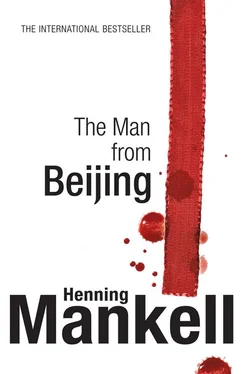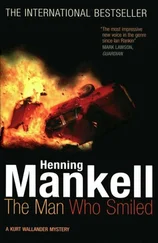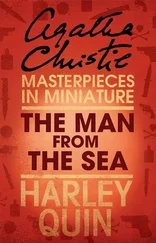At least, that was the case among her generation and those who were older. She didn’t know what the younger generation thought about publicity.
The thermometer outside the kitchen window indicated that the temperature had fallen. She switched on the television to watch the evening news. Then she would go to bed. The day spent with Karin Wiman had been very eventful and also very tiring.
She had missed the beginning of the news bulletin, but it was obvious that something dramatic had happened in connection with the Hesjövallen case. A reporter was interviewing a criminologist who was verbose but serious. She tried to work out what was going on.
When the crime expert had finished speaking, the screen was filled with pictures from Lebanon. She cursed, switched over to teletext and discovered immediately what had happened.
Lars-Erik Valfridsson had taken his own life. Despite being checked every fifteen minutes, he had managed to tear a shirt into strips, make a noose and hang himself. Although he had been discovered almost immediately, it had not been possible to revive him.
Birgitta Roslin switched off the television. Her head was swimming. Had he been unable to live with all the guilt weighing him down? Or was he mentally ill?
Something doesn’t add up, she thought. It can’t be him. Why did he kill himself, why did he confess and why did he lead the police to a buried samurai sword?
It simply doesn’t make sense.
She sat down in the armchair she used for reading, but switched off the lamp. The room was in semi-darkness. Somebody laughed as they went past in the street. She would often sit here and contemplate her work.
She returned to the beginning. It was too much, she thought. Perhaps not too much for a ruthless and obsessed man to carry out. But too much for a man from Hälsingland with no more of a criminal background than a few cases of assault. He confesses to something he didn’t do. Then he gives the police a weapon he’s made himself and hangs himself in his cell. I might be wrong, of course, but I don’t think it adds up. They arrested him far too quickly. And what on earth could be the revenge he claimed was his motive?
It was midnight when she finally got up from her armchair. She wondered if she ought to call Staffan, but he might well be asleep by now. She went to bed and turned off the light. In her thoughts she was wandering around the village once more. Over and over again she envisaged the red ribbon that had been found in the snow, and the picture of the Chinese man from the hotel’s home-made surveillance camera. The police must know something I don’t know, why Lars-Erik Valfridsson was arrested and what might have been a plausible motive. But they are making a mistake by locking themselves into one single line of investigation.
She couldn’t sleep. When she could no longer deal with all the tossing and turning, she put on her dressing gown and went downstairs again. She sat at her desk and wrote a summary of all the events that linked her to Hesjövallen. It took her almost three hours to relive in detail all the things she knew. As she wrote she was nagged by the feeling that there was something she’d missed, a connection she hadn’t seen. Her pen seemed to her like a chainsaw clearing the undergrowth in a forest, and she needed to be careful in case there was a young deer hiding there. When she finally straightened her back and raised her arms over her head, it was four in the morning. She took her notes to her chair, adjusted the lamp and started reading them through, trying to look between the words, or rather behind them, searching for something she’d overlooked. But nothing unusual attracted her attention, no link that she should have noticed sooner.
But she was convinced: this couldn’t be the handiwork of a lunatic. It was too well organised, too cold-blooded, to have been carried out by anyone but a totally calm and cool killer. Possibly, she noted in the margin, one should ask if the man had been in the place before. It was pitch dark, but he might have had a powerful torch. Several of the doors were locked. He must have known exactly who lived where, and probably also had keys. His motive must have been very compelling, so that he never hesitated for one second.
A thought suddenly struck her, something that hadn’t occurred to her before. Had the man who committed the murders shown his face to those over whom he raised his sword or sabre? Did he want them to see him?
That’s a question for Vivi Sundberg to answer, she thought. Was the light on in the rooms where the dead bodies were found? Had they looked into the face of death before the sword fell?
She put her notes away; it was nearly five. She checked the thermometer outside the kitchen window and saw that the temperature had fallen to minus eight Celsius. She drank a glass of water and went to bed. She was on the point of falling asleep when she was dragged up to the surface again. There was something she’d missed. Two of the dead bodies had been tied to each other. Where had she seen that image before? She sat up in bed in the darkness, suddenly wide awake. She had seen a description of a similar scene somewhere.
The diaries. She went downstairs, laid them all out on the table and started looking. She found the passage she was searching for almost immediately.
It’s 1865. The railway is meandering eastward, every sleeper, every rail, is torture. The workers are struck down by illnesses. They’re dropping like flies. But the flood of replacement workers from the West means the work can continue at the high speed that is essential if the whole of the gigantic railway programme is not to be crippled by financial collapse. On one occasion, to be more precise on 9 November, JA hears that a Chinese slave ship is on its way from Canton. It’s an old sailing ship, only used now for shipping kidnapped Chinese to California. Trouble breaks out on board when food and water begin to run out as the vessel is becalmed for an unusually long period. In order to quash the revolt, the captain resorts to methods of unparalleled cruelty. Even JA, who doesn’t hesitate to use both fists and whips to make his labourers work harder, finds what he hears distressing. The captain seizes some of the leading troublemakers, kills them and ties them to other Chinese who are still alive, two at a time. Then they are forced to lie on deck, one of each pair slowly starving to death, the other decomposing. JA notes in his diary that ‘the punishment is excessive’.
Could there be a link? Perhaps one of them in Hesjövallen had been forced to lie with a dead body lashed to his or her own? For a whole hour perhaps, maybe less, maybe more? Before the final blow brought release?
I missed that, she thought. Did the Hudiksvall police miss it as well? They can’t have read the diaries all that carefully before I was allowed to borrow them.
But another question suggested itself, even if it seemed to be basically implausible. Did the murderer know about the events described in JA’s diary? Was there a remarkable link spanning both time and space?
Maybe Vivi Sundberg was more cunning than Roslin thought.
Perhaps Vivi Sundberg even appreciated her stubbornness. She was a woman who had probably experienced problems with her annoying male colleagues.
Birgitta Roslin slept until ten, got up and saw from Staffan’s schedule that he was due back in Helsingborg at about three o’clock. She was just about to sit down and make a call to Sundberg when there was a ring at the front door. When she answered it, she found a short Chinese man standing with a takeaway meal wrapped up in plastic in his hand.
‘I haven’t ordered anything,’ said Birgitta Roslin in surprise.
‘From Li in Hudiksvall,’ said the man with a smile. ‘It costs nothing. She wants you to call her. We are family business.’
Читать дальше












